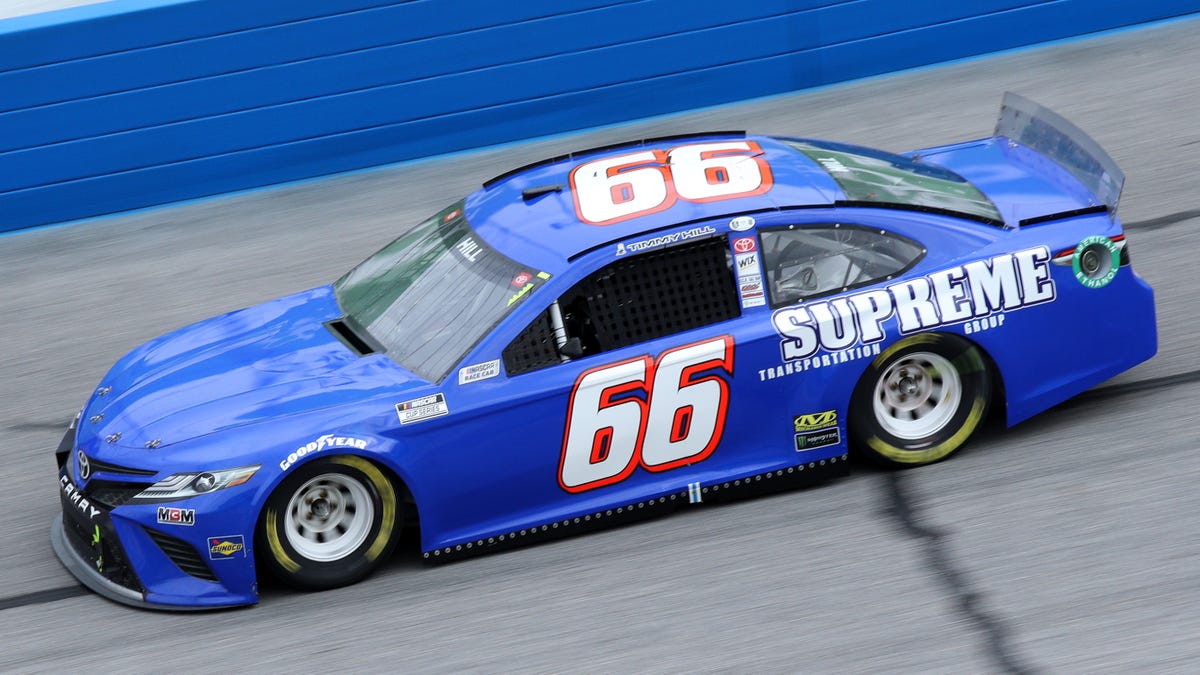
If you missed it, NASCAR hosted a sim race that was broadcast on television in the middle of the week. It’s part of the series’ push to broaden its scope after the success of the events during 2020’s COVID-19 shutdown, resulting in this year’s Pro Invitational mini-championship. But a series of mishaps—including the very way drivers were invited to compete in the event—has highlighted some of NASCAR’s bigger problems.
The big drama came down to Timmy Hill, a driver that regularly competes in all three of NASCAR’s main divisions: Trucks, Xfinity, and Cup. He’s a part-time driver that competes near the end of the grid with an underfunded team, but the leveled playing field provided by iRacing allowed Hill to shine in 2020. He finished in the top 10 in every virtual race hosted during the coronavirus shutdown, and he won the event at Texas Motor Speedway.
So, it would make sense that Hill would once again be competing in NASCAR’s virtual championship. Except, he wasn’t invited.
As it turns out, NASCAR provided guaranteed entry to all chartered cars, which are cars that agree to race for a certain number of years in exchange for guaranteed entry into NASCAR races. A few other slots were reserved for celebrity guest drivers, in this case including Dale Earnhardt Jr. and Clint Bowyer—though it was later indicated that FOX and NASCAR could have opted to add more guest slots if they saw fit. With his part-time effort, Hill obviously does not have the charter that would guarantee his entry.
But his track record in virtual events—and the fact that he was used in promotional material for the 10-race virtual championship—left him thinking he would be invited. He only found out about NASCAR’s charter strategy when the race lineup was announced on Twitter the day before the race.
G/O Media may get a commission
In an interview with Frontstretch, Hill revealed that he’d been counting on those virtual races. He’d leveraged his performance in them as a way to garner sponsorship for the 2021 season.
“Really, we had a lot of people who had interest in [sponsorship],” Hill told Frontstretch. “We kind of had to put it on hold, because we told them that we’ve really been left out of the loop on this deal, nobody [from NASCAR] will respond to us.
“I guess the reason is because they knew all along that they didn’t either want us in the series or knew that they weren’t gonna have us. Communication was really not there. It seems to be a common theme that we just kind of get left out.”
Because of the snub and subsequent loss of sponsorship activation, Hill’s No. 66 MBM Motorsport entry was expected to miss several real-life races. The only reason his team was even attempting a full Cup Series season this year was because of the extra dollars the Pro Invitational performances could bring.
And Hill had reason to believe he’d be part of the event:
“When they first announced [the Pro Invitational] they said, ‘All full-time drivers and teams will be invited and actually are required to participate in it,’” he said to Frontstretch. “We had success with the Pro Invitational last year that we actually kind of game-planned around that event. For the Cup season, we actually purposely ran all the races this year just so we could meet all the criteria that we thought we had to make to be part of this.”
After hours of fans using the #LetTimmyRace hashtag to show their support for Hill on Twitter, he reached a shaky conclusion. Team Penske driver Brad Keselowski had opted out of competing in the event, handing his virtual No. 2 car over to Xfinity driver Austin Cindric. Cindric, in turn, offered to step back to let Hill race. As kind of a gesture as it was, it didn’t solve the No. 66 team’s exposure problem.
Carl Long, MBM team owner, expects the team will be invited to the rest of the Pro Invitational events.
The whole debacle highlights a lot of issues within NASCAR’s hierarchy, specifically the fact that the sport is expensive and that the charter system tends to exacerbate those problems. There’s very little space for a brand-new, full-time team in the sport, and the most vulnerable teams are the ones that are given the least help to succeed.
But it also highlights NASCAR’s deeper lack of creativity. The Powers That Be have tried a lot of ways to artificially create more competition. From stages to playoffs to the introduction of several tons of dirt to an asphalt track, the sport has attempted to bring drivers closer together and throw in an element of unpredictability, which often has the undesirable trade-off of the sport coming across as gimmicky. The Pro Invitational Series is one of NASCAR’s best ideas yet when it comes to bolstering the little teams because sim racing involves a talent level of its own, and the cars aren’t stratified by millions of dollars.
But NASCAR failed to see the draw in that, and it came at a cost to one of the teams actually trying to break into the sport. Fans loved seeing Hill have a chance to compete at the front of the field, and the simulated events were a nice break from the usual hot-and-heavy pressure of a real-life event. That was a large reason why folks bothered to tune in.
The debacle made for some good media, and Hill did admittedly receive more media attention than he normally would have. But NASCAR has once again proven that the odds are stacked against burgeoning teams that don’t have the ability to buy a charter or compete at a loss.
